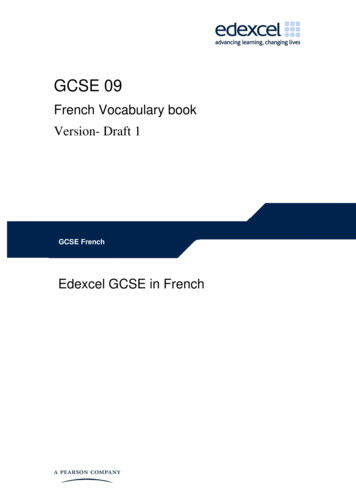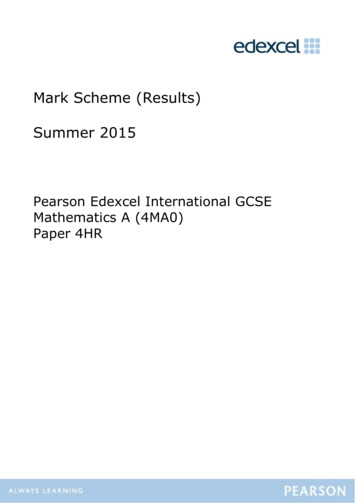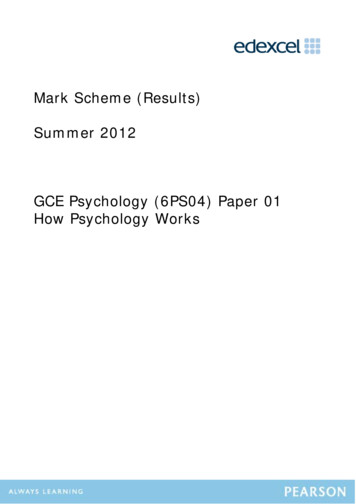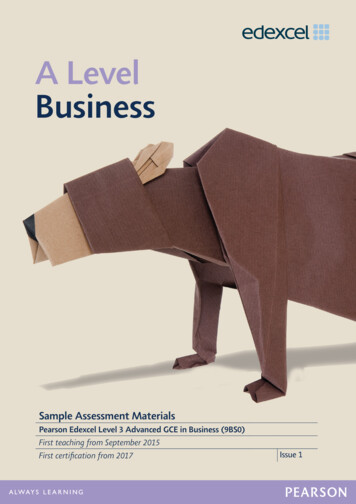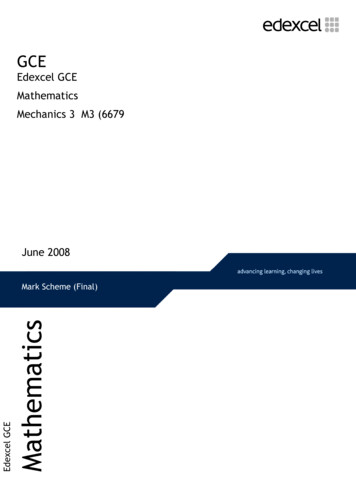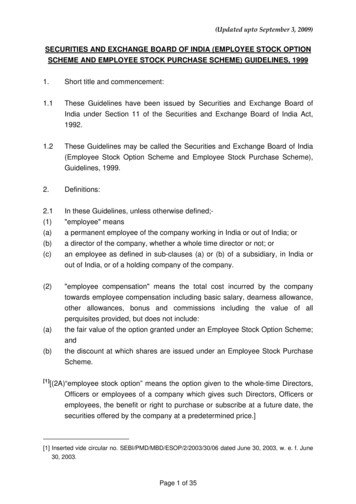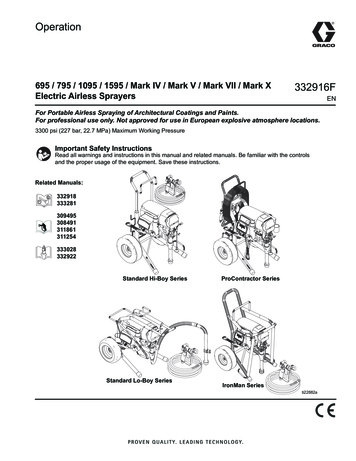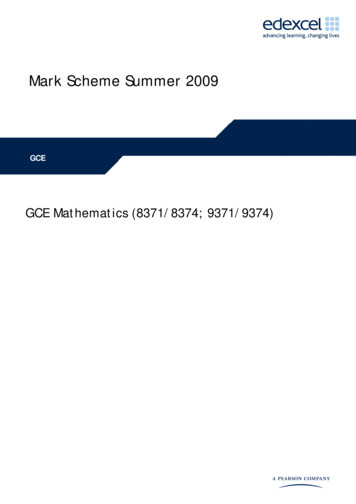
Transcription
Mark Scheme Summer 2009GCEGCE Mathematics (8371/8374; 9371/9374)
Edexcel is one of the leading examining and awarding bodies in the UK andthroughout the world. We provide a wide range of qualifications including academic,vocational, occupational and specific programmes for employers.Through a network of UK and overseas offices, Edexcel’s centres receive the supportthey need to help them deliver their education and training programmes to learners.For further information, please call our GCE line on 0844 576 0025, our GCSE team on0844 576 0027, or visit our website at www.edexcel.com.If you have any subject specific questions about the content of thisMark Scheme that require the help of a subject specialist, you mayfind our Ask The Expert email service helpful.Ask The Expert can be accessed online at the following mer 2009Publications Code UA021531All the material in this publication is copyright Edexcel Ltd 2009
Contents1.6663 Core Mathematics 152.6664 Core Mathematics 2173.6665 Core Mathematics 3274.6666 Core Mathematics 4395.6667 Further Pure Mathematics 1 (new)476.6668 Further Pure Mathematics 2 (new)557.6669 Further Pure Mathematics 3 (new)658.6674 Further Pure Mathematics 1 (legacy)739.6675 Further Pure Mathematics 2 (legacy)8110.6676 Further Pure Mathematics 3 (legacy)8711.6677 Mechanics 19312.6678 Mechanics 29713.6679 Mechanics 310314.6680 Mechanics 410915.6681 Mechanics 511516.6683 Statistics 112117.6684 Statistics 212918.6691 Statistics 313719.6686 Statistics 414520.6689 Decision Mathematics 115121.6690 Decision Mathematics 21618371 9374 GCE Mathematics June 20093
8371 9374 GCE Mathematics January 20094
June 20096663 Core Mathematics C1Mark SchemeQuestionNumberQ1(a)(b)Scheme(3 7) 63(8 5)(2 5) 16 5 2 5 8 52MarksB1(1)M1 11, 6 5A1, A1(3)[4](a) B1(b) M1for 63 onlyfor an attempt to expand their brackets with 3 terms correct.They may collect the 5 terms to get 16 5 6 5 5 5 or ( 5)2Allowor 25 instead of the -5These 4 values may appear in a list or table but they should have minus signsincludedThe next two marks should be awarded for the final answer but check thatcorrect values follow from correct working. Do not use ISW rule1st A1 for 11 from 16 – 5 or 6 5 from 8 5 2 52nd A1 for both 11 and 6 5 .S.C - Double sign error in expansionFor 16 5 2 5 8 5 leading to 11 allow one mark8371 9374 GCE Mathematics January 20095
QuestionNumberQ2Scheme32 2 5 or 2048 211 ,a 2 21Marks12048 ( 2048) 22 orB1, B11 or 5 or 5.5 2 112B1[3]1st B1 for 32 25 or 2048 211This should be explicitly seen: 32 2 2a followed by 25 2 2a is OKEven writing 32 2 25 2 26 is OK but simply writing 32 2 26 is NOT(1)12nd B1 for 2 2 or ( 2048) 2 seen. This mark may be implied113rd B1 for answer as written. Need a so 2 2 is B011 1 or 5 or 5.5 with no working scores full marks.2 2 If a 5.5 seen then award 3/3 unless it is clear that the value followsfrom totally incorrect work.Part solutions: e.g. 2 5 2 scores the first B1.a Special case:If2 212is not explicitly seen, but the final answer includese.g. a 21,211, a 4 , the second B1 is given by implication.228371 9374 GCE Mathematics January 20096
QuestionNumberQ3(a)(b)SchemeMarksdy 6 x 2 6 x 3dx4M1 A1 A1(3) 12x3x( C ) 14M1 A1x4 3 x 1 C2A1(3)[6](a) M1for an attempt to differentiate x n x n 11st A1 for 6x 262nd A1 for 6 x 3 or 3 Condone 6x 3 here. Inclusion of c scores A0 here.x(b) M11st A1for some attempt to integrate an x term of the given y. x n x n 1for both x terms correct but unsimplified- as printed or better. Ignore chere2nd A1for both x terms correct and simplified and c. Accept 3but NOTx 3 x 1Condone the c appearing on the first (unsimplified) line but missing on thefinal (simplified) lineApply ISW if a correct answer is seenIf part (b) is attempted first and this is clearly labelled then apply the scheme andallow the marks. Otherwise assume the first solution is for part (a).8371 9374 GCE Mathematics January 20097
QuestionNumberQ4Scheme(a)5 x 10 , x 2 [Condone x 102 2 for M1A1](b)3(2 x 3)( x 4) 0 , ‘Critical values’ are and 423 x 42MarksM1, A1(2)(c)2 x 4Must have a or b correct so eg 3x 4 scores M0(b) 1st M1for an attempt to factorize or solve to find critical values. Method mustpotentially give 2 critical values331st A1 for and 4 seen. They may write x , x 4 and still get this A122nd2 M1 for choosing the “inside region” for their critical values2nd A1ft follow through their 2 distinct critical values3Allow x with “or” “,” “ ” “ “ x 4 to score M1A0 but “and” or “ “ score2M1A1x ( 32 ,4) is M1A1 but x [ 32 ,4] is M1A0 . Score M0A0 for a number line or graphonlyNBAllow if a correct answer is seen or follow through their answer to (a) andtheir answer to (b) but their answers to (a) and (b) must be regions. Do notfollow through single values.If their follow through answer is the empty set accept or {} or equivalent inwordsIf (a) or (b) are not given then score this mark for caoYou may see x 4 (with anything or nothing in-between) x -1.5 in (b) andempty set in (c) for B1ftDo not award marks for part (b) if only seen in part (c)Use of instead of (or instead of ) loses one accuracy mark only, at firstoccurrence.8371 9374 GCE Mathematics January 2009M1 A1ftB1ft(a) M1 for attempt to collect like terms on each side leading to ax b , or ax b, or ax b(c) B1ftM1, A18(4)(1)[7]
QuestionNumberQ5SchemeMarksa 9d 2400a 39d 600 1800d 60( accept 60 for A1)d 30(b) a 540 2400a 2940(c)11Total n{2a (n 1)d } 40 (5880 39 60 ) (ft values of a and d)22 70 800(a)Note:If the sequence is considered ‘backwards’, an equivalent solution may be given usingd 60 with a 600 and l 2940 for part (b). This can still score full marks. Ignorelabelling of (a) and (b)(a)1st M1 for an attempt to use 2400 and 600 in a ( n 1) d formula. Must use bothvaluesi.e. need a pd 2400 and a qd 600 where p 8 or 9 and q 38 or 39(any combination)2nd M1 for an attempt to solve their 2 linear equations in a and d as far as d A1for d 60. Condone correct equations leading to d 60 or a 8d 2400anda 38d 600 leading to d - 60. They should get penalised in (b) and (c).NB This is a “one off” ruling for A1. Usually an A mark must follow from theirwork.ALT1st M1 for (30d) (2400 - 600)( 2400 600 )2nd M1 for ( d ) 30A1for d 60a 9d 600, a 39d 2400 only scores M0 BUT if they solve to find d 60 thenuse ALT scheme above.(b) M1 for use of their d in a correct linear equation to find a leading to a A1 their a must be compatible with their d so d 60 must have a 600 and d -60,a 2940So for example they can have 2400 a 9(60) leading to a for M1 but itscores A0Any approach using a list scores M1A1 for a correct a but M0A0 otherwise(c) M1for use of a correct Sn formula with n 40 and at least one of a, d or lcorrect or correct ft.1st A1ft for use of a correct S40 formula and both a, d or a, l correct or correct followthroughALTTotal 11n{a l} 40 (2940 600 )222nd A1 for 70800 only8371 9374 GCE Mathematics January 20099(ft value of a) M1 A1ftM1M1 A1(3)M1 A1(2)M1 A1ftA1cao(3)[8]
QuestionNumberQ6SchemeMarksb 2 4ac attempted, in terms of p.o.e.(3 p ) 2 4 p 0Attempt to solve for p e.g. p ( 9 p 4 ) 0 Must potentially lead to p k, k 0p 49(Ignore p 0, if seen)M1A1M1A1cso[4]1st M1 for an attempt to substitute into b 2 4ac or b 2 4ac with b or c correctCondone x’s in one term only.This can be inside a square root as part of the quadratic formula for example.Use of inequalities can score the M marks only1st A1 for any correct equation: ( 3 p ) 4 1 p 0 or better22nd M1 for an attempt to factorize or solve their quadratic expression in p.4Method must be sufficient to lead to their p .92 2Accept factors or use of quadratic formula or ( p 9 ) k 2 (o.e. eg) (3 p equivalent work on their eqn.9 p2 4 p )2 23 k 2 or9p2 4 which would lead to 9p 4 is OK for this 2nd M1pALTM1Comparing coefficients2for (x α ) x 2 α 2 2αx and A1 for a correct equation eg 3 p 2 pM1for forming solving leading top 23or betterUse of quadratic/discriminant formula (or any formula) Rule for awarding M markIf the formula is quoted accept some correct substitution leading to a partiallycorrect expression.If the formula is not quoted only award for a fully correct expression usingtheir values.8371 9374 GCE Mathematics January 200910
QuestionNumberQ7(a)(b)(c)Scheme(a2 )2k 7(a3 )2(2k 7) 7 or 4k 14 7, 4k 21( a4 ) 2(4k 21) 7MarksB1(*)(1)M1, A1cso(2)( 8k 49)M14 ar k "(2k 7)" (4k 21) "(8k 49)"r 1k ( 2k 7) ( 4k 21) (8k 49) 15k 77 43M1k 8(b) M1must see 2(their a2 ) - 7 or 2(2k 7) 7 or 4k – 14 – 7 . Their a2 must be afunction of k.A1cso must see the 2(2k 7) 7 or 4k – 14 – 7 expression and the 4k - 21 with noincorrect working(c) 1st M1 for an attempt to find a4 using the given rule. Can be awarded for 8k - 49seen.Use of formulae for the sum of an arithmetic series scores M0M0A0 for thenext 3 marks.2nd M1 for attempting the sum of the 1st 4 terms. Must have “ ” not just , or clearattempt to sum.Follow through their a2 and a4 provided they are linear functions of k.Must lead to linear expression in k. Condone use of their linear a3 4k 21here too.3rd M1 for forming a linear equation in k using their sum and the 43 and attempt tosolve for k as far as pk q120A1for k 8 only so k is A015Answer Only (e.g. trial improvement)Accept k 8 only if 8 9 11 15 43 is seen as wellSum a2 a3 a4 a5 or a 2 a3 a 4Allow: M1 if 8k - 49 is seen, M0 for the sum (since they are not adding the 1st 4terms) then M1if they use their sum along with the 43 to form a linear equation and attempt to solvebut A08371 9374 GCE Mathematics January 200911M1 A1(4)[7]
QuestionNumberQ8Scheme(a)AB: m 2 7 5 , 8 6 2 Using m1m2 1 : m2 y 7 (b)B1252( x 6) ,5M12 x 5 y 23 0Using x 0 in the answer to (a), y (c)MarksArea of triangle (o.e. with integer coefficients) M1, A1 (4)23or 4.65123 92(o.e) 8 255M1, A1ft (2)184 2e.g. 18 , 18.4, 10 5M1 A1(2)[8]B1 for an expression for the gradient of AB. Does not need the 2.51 M1 for use of the perpendicular gradient rule. Follow through their m2nd M1 for the use of (6, 7) and their changed gradient to form an equation for l.y 7 2Can be awarded for o.e.x 6 5Alternative is to use (6, 7) in y mx c to find a value for c. Score whenc is reached.A1for a correct equation in the required form and must have “ 0” and integercoefficients(b) M1for using x 0 in their answer to part (a) e.g. 5 y 23 023A1ftfor y provided that x 0 clearly seen or C (0, 4.6). Follow through5their equation in (a)If x 0, y 4.6 are clearly seen but C is given as (4.6,0) apply ISW andaward the mark.This A mark requires a simplified fraction or an exact decimalAccept their 4.6 marked on diagram next to C for M1A1ft(c) M1for 12 8 yC so can follow through their y coordinate of C.(a)stA1for 18.4 (o.e.) but their y coordinate of C must be positiveUse of 2 triangles or trapezium and triangleAward M1 when an expression for area of OCB only is seenDeterminant approachAward M1 when an expression containing8371 9374 GCE Mathematics January 2009121 8 yC2is seen
QuestionNumberQ9Scheme(a)(b)(c)(a)Marks (3 4 x ) 2 9 12 x 12 x ( 4 )2 x 9x 12M112A1, A1 16 x 243(3)19 16 f ′( x) x 2 , x 222M1 A1, A1ft9 1 16 11 16 5f ′(9) 2 27 2 36 6 2M1 A1(3)([8])2M1for an attempt to expand 3 4 x with at least 3 terms correct- as printedor betterOr 9 k x 16 x (k 0) . See also the MR rule below1st A12nd A1(b) M1for their coefficient of x 16. Condone writing ( )9 xfor B - 24 or their constant term - 24( ) 12instead of 9 x 12for an attempt to differentiate an x term x n x n 131st A19 1 3for x 2 and their constant B differentiated to zero. NB 9 x 2 is A02212nd A1ft follow through their Ax 2 but can be scored without a value for A, i.e. for1A 2x2(c) M1for some correct substitution of x 9 in their expression for f ′( x ) including an attemptkat ( 9 ) 2 (k odd) somewhere that leads to some appropriate multiples of 1 or 33A145 13567.515acceptor any exact equivalent of 2.5 e.g.,or even18 54276Misread (MR) Only allow MR of the form ( 3 k x )xScore as M1A0A0, M1A1A1ft, M1A1ft8371 9374 GCE Mathematics January 2009(2)1322N.B. Leads to answer in (c) of k 16
QuestionNumberSchemeQ10 (a)x ( x 2 6 x 9) x( x 3)( x 3)(b)6MarksB1ShapeyM1 A1B1(3)54321x 11234 2(c)563 16Through origin (not touching)Touching x-axis only onceTouching at (3, 0), or 3 on x-axis[Must be on graph not in a table]B1B1B1ftMoved horizontally (either way)(2, 0) and (5, 0), or 2 and 5 on x-axisM1A1 (2)(4)y543221x 11234565 1 2(a) B1M1[9]for correctly taking out a factor of xfor an attempt to factorize their 3TQ e.g. ( x p)( x q) where pq 9 .So ( x 3)( x 3) will score M1 but A0for a fully correct factorized expression - accept x ( x 3) 2If they “solve” use ISWS.C.If the only correct linear factor is (x - 3), perhaps from factor theorem, awardB0M1A0Do not award marks for factorising in part (b)A1For the graphs“Sharp points” will lose the 1st B1 in (b) but otherwise be generous on shapeCondone (0, 3) in (b) and (0, 2), (0,5) in (c) if the points are marked in thecorrect places.(b) 2nd B1 for a curve that starts or terminates at (0, 0) score B04th B1ft for a curve that touches (not crossing or terminating) at (a, 0) where theiry x ( x a)2(c) M1for their graph moved horizontally (only) or a fully correct graphCondone a partial stretch if ignoring their values looks like a simpletranslationA1for their graph translated 2 to the right and crossing or touching the axis at 2and 5 onlyAllow a fully correct graph (as shown above) to score M1A1 whateverthey have in (b)8371 9374 GCE Mathematics January 200914
QuestionNumberQ11 (a)(b)(c)Schemey 8 8 2 9 7 (*)x 2:dy 3x 2 4 x 1dxdyx 2: 12 8 1( 3)dxy 7 3( x 2) ,m MarksB1M1 A1A1fty 3x 113M1, A1 (5)(for 1with their m) B1ftm4213 x 2 4 x 1 , 9 x 2 12 x 2 0 or x 2 x 0 (o.e.)393 12 144 72 x 216 36 6 6 6 or (3 x 2 )2 6 3 x 2 6 18 1(*)x 2 63((M1, A1)M1)A1csothere must be a clear attempt to substitute x 2 leading to 7e.g. 2 2 2 2 2 9 7(b) 1st M1 for an attempt to differentiate with at least one of the given terms fullycorrect.1st A1 for a fully correct expressiondy2nd A1ft for sub. x 2 in their( y ) accept for a correct expression e.g.dx23 (2 ) 4 2 1dy2nd M1 for use of their “3” (provided it comes from their ( y ) and x 2) to finddxequation of tangent. Alternative is to use (2, 7) in y mx c to find a value for c.Award when c is seen.dyNo attempted use ofin (b) scores 0/5dx(c)dy11st M1 for forming an equation from their( y ) and their (must bedxmchanged from m)1st A1 for a correct 3TQ all terms on LHS (condone missing 0)2nd M1 for proceeding to x or 3x by formula or completing the square fora 3TQ.Not factorising. Condone 2nd A1 for proceeding to given answer with no incorrect working seen. Can stillhave .ALT Verify (for M1A1M1A1)3for attempting to square need 3 correct values in4 6 4 69, 1st A1 for2nd M1 Dependent on 1st M1 in this case for substituting in all terms of their2nd A1csofor cso with a full comment e.g. “the x co-ord of Q is .”8371 9374 GCE Mathematics January 200915(5)[11](a) B11st M1(1)10 4 69dydx
8371 9374 GCE Mathematics January 200916
June 20096664 Core Mathematics C2Mark SchemeQuestionNumberQ1SchemeMarks321 2 2 dx 2 x 3 x2x 3x 32 2M1 A1A1443 1 2 dx x 2 2 x 22x 3x (16 2 8 ) (1 2 ) 11 29M1(29 C scores A0)A1(5)[5]st12321 M1 for attempt to integrate x kx or x kx .1st A12for2nd A1 for2x 2or a simplified version.2323x3x xoror a simplified version.3322( )( )Ignore C, if seen, but two correct terms and an extra non-constant term scores M1A1A0.2nd M1 for correct use of correct limits ('top' 'bottom'). Must be used in a 'changedfunction', not just the original. (The changed function may have been found bydifferentiation).Ignore 'poor notation' (e.g. missing integral signs) if the intention is clear.No working:The answer 29 with no working scores M0A0A0M1A0 (1 mark).8371 9374 GCE Mathematics January 200917
QuestionNumberQ2(a)Scheme(7 . x )or(21 . x )2The 7 or 21 can be in ‘unsimplified’ form.MarksM1 7 2 2 k x 2 ( 2 kx )7 27 26 7 kx 25 128;(b) 448kx, 672k 2 x 2 [or 672(kx) 2 ](If 672kx 2 follows 672(kx) 2 , isw and allow A1)6 448k 672k 2k 4B1; A1, A1(4)M1(Ignore k 0, if seen)A1(a) The terms can be ‘listed’ rather than added. Ignore any extra terms.M1 for either the x term or the x 2 term. Requires correct binomial coefficient in any formwith the correct power of x, but the other part of the coefficient (perhaps includingpowers of 2 and/or k) may be wrong or missing. 7 7 7 Allow binomial coefficients such as , , , 7 C1 , 7 C 2 . 1 1 2 However, 448 kx or similar is M0.B1, A1, A1 for the simplified versions seen above.Alternative:7kx 77 Note that a factor 2 can be taken out first: 2 1 , but the mark scheme still applies.2 Ignoring subsequent working (isw):Isw if necessary after correct working:e.g. 128 448kx 672k 2 x 2 M1 B1 A1 A1 4 14kx 21k 2 x 2isw(Full marks are still available in part (b)).(b)M1 for equating their coefficient of x 2 to 6 times that of x to get an equation in k, or equating their coefficient of x to 6 times that of x 2 , to get an equation in k.Allow this M mark even if the equation is trivial, providing their coefficients from part (a)have been used, e.g. 6 448k 672k , but beware k 4 following from this, which is A0.An equation in k alone is required for this M mark, so.e.g. 6 448kx 672k 2 x 2 k 4 or similar is M0 A0 (equation in coefficients only isnever seen), but .e.g. 6 448kx 672k 2 x 2 6 448k 672k 2 k 4 will get M1 A1(as coefficients rather than terms have now been considered).7 kx The mistake 2 1 would give a maximum of 3 marks: M1B0A0A0, M1A12 8371 9374 GCE Mathematics January 200918(2)[6]
QuestionNumberQ3SchemeMarks(a)f ( k ) 8(b)f (2) 4 4 (6 2)(2 k ) 8M1Sok 1A1(c)B1f ( x) 3x 2 ( 2 3k ) x ( 2k 8 ) 3 x 2 x 10 (3x 5)(x 2)(1)(2)M1M1A1(3)[6](b) M1 for substituting x 2 (not x 2 ) and equating to 4 to form an equation in k.If the expression is expanded in this part, condone ‘slips’ for this M mark.Treat the omission of the 8 here as a 'slip' and allow the M mark.Beware:Substituting x 2 and equating to 0 (M0 A0) also gives k 1 .Alternative;M1 for dividing by ( x 2) , to get 3 x (function of k), with remainder as a function of k,and equating the remainder to 4. [Should be 3x (4 3k ) , remainder 4k ].No working:k 1 with no working scores M0 A0.(c)1st M1 for multiplying out and substituting their (constant) value of k (in either order).The multiplying-out may occur earlier.Condone, for example, sign slips, but if the 4 (from part (b)) is included in the f(x)expression, this is M0. The 2nd M1 is still available.2nd M1 for an attempt to factorise their three term quadratic (3TQ).A1 The correct answer, as a product of factors, is required.5 Allow 3 x ( x 2)3 Ignore following work (such as a solution to a quadratic equation).If the ‘equation’ is solved but factors are never seen, the 2nd M is not scored.8371 9374 GCE Mathematics January 200919
QuestionNumberQ4Scheme(a) x 2gives 2.236 (allow AWRT) Accept 5x 2.5 gives 2.580(b) 1 1 , 2 2 (allow AWRT) Accept 2.58MarksB1B1(2)[(1.414 3) 2(1.554 1.732 1.957 2.236 2.580)]B1,[M1A1ft] 6.133 (AWRT 6.13, even following minor slips)A1(4)(c)OverestimateB1'Since the trapezia lie above the curve', or an equivalent explanation,or sketch of (one or more) trapezia above the curve on a diagram (or on the givendiagram, in which case there should be reference to this).(Note that there must be some reference to a trapezium or trapezia in the explanationor diagram).(b)B1 fordB1(2)[8]1 1 or equivalent.2 2For the M mark, the first bracket must contain the 'first and last' values, and the secondbracket (which must be multiplied by 2) must have no additional values. If the only mistake is toomit one of the values from the second bracket, this can be considered as a slip and the M mark canbe allowed. 1 1 Bracketing mistake: i.e. (1.414 3) 2(1.554 1.732 1.957 2.236 2.580) 2 2 scores B1 M1 A0 A0 unless the final answer implies that the calculation has been donecorrectly (then full marks can be given).Alternative:Separate trapezia may be used, and this can be marked equivalently.11 1 4 (1.414 1.554) 4 (1.554 1.732) . 4 (2.580 3) 1st A1ft for correct expression, ft their 2.236 and their 2.580(c)1st B1 for 'overestimate', ignoring earlier mistakes and ignoring any reasons given.2nd B1 is dependent upon the 1st B1 (overestimate).8371 9374 GCE Mathematics January 200920
QuestionNumberQ5(a)Scheme324r 3 96r (b)(c)orr3 96324S M1827(*)2(d)r3 23A1cso(2)5 2 2 a 324 or a 96 3 3 S15 orMarks(15729 1 23 1 23729,1 23),a . ,729 2182.00 M1, A1 (2)(AWRT 2180)M1A1ft, (3)M1, A1 (2) 2187[9](a) M1for forming an equation for r 3 based on 96 and 324 (e.g. 96r 3 324 scores M1).The equation must involve multiplication/division rather than addition/subtraction.A1Do not penalise solutions with working in decimals, providing these are correctlyrounded or truncated to at least 2dp and the final answer 2/3 is seen.Alternative: (verification)82M1Using r 3 and multiplying 324 by this (or multiplying by r three times).273A1Obtaining 96 (cso). (A conclusion is not required).3 2 324 96 (no real evidence of calculation) is not quite enough and scores M1 A0. 3 (b)2M1for the use of a correct formula or for 'working back' by dividing by (or by their r) twice3from 324 (or 5 times from 96).Exceptionally, allow M1 also for using ar 3 324 or ar 6 96 instead of ar 2 324 or ar 5 96 , orfor dividing by r three times from 324 (or 6 times from 96) but no other exceptions are allowed.(c) M1for use of sum to 15 terms formula with values of a and r. If the wrong power is used,e.g. 14, the M mark is scored only if the correct sum formula is stated.21st A1ft for a correct expression or correct ft their a with r .3nd2 A1 for awrt 2180, even following 'minor inaccuracies'.2Condone missing brackets round the for the marks in part (c).3Alternative:2M1for adding 15 terms and 1st A1ft for adding the 15 terms that ft from their a and r .3(d) M1for use of correct sum to infinity formula with their a. For this mark, if a value of rdifferent from the given value is being used, M1 can still be allowed providing r 1 .8371 9374 GCE Mathematics January 200921
QuestionNumberQ6(a)(b)Scheme( x 3)2 9 ( y 2 )2 4 12( x 3)2 ( y 2 )2 12 "9" "4"MarksM1 A1, A1Centre is (3, 2)r 12 "9" "4" 5 (or25 )PQ (7 1) 2 ( 5 1) 2 or 82 62 10 2 radius, diam. (N.B. For A1, need a comment or conclusion)[ALT: midpt. of PQ 7 ( 1) , 1 ( 5) : M1, (3, 2) centre: A1] 22M1 A1 (5)M1A1 verify (3, 2) lies on this: A1][ALT: eqn. of PQ 3x 4 y 1 0 : M1,[ALT: find two grads, e.g. PQ and P to centre: M1, equal diameter: A1][ALT: show that point S ( 1, 5) or (7, 1) lies on circle: M1because PSQ 90 , semicircle diameter: A1](c) R must lie on the circle (angle in a semicircle theorem) often implied by a diagramwith R on the circle or by subsequent working)x 0 y 2 4 y 12 0(y 2)(y 6) 0 y .(M is dependent on previous M)y 6 or 2 (Ignore y 6 if seen, and 'coordinates' are not required))B1M1dM1A1(a) 1st M1 for attempt to complete square. Allow ( x 3) 2 k , or ( y 2) 2 k , k 0 .1st A1 x-coordinate 3, 2nd A1 y-coordinate 23rd A1 5 or 252nd M1 for a full method leading to r , with their 9 and their 4,The 1st M can be implied by ( 3, 2) but a full method must be seen for the 2nd M.Where the 'diameter' in part (b) has clearly been used to answer part (a), no marks in (a),but in this case the M1 (not the A1) for part (b) can be given for work seen in (a).Alternative1st M1 for comparing with x 2 y 2 2 gx 2 fy c 0 to write down centre ( g , f )directly. Condone sign errors for this M mark.nd2 M1 for using r g 2 f 2 c . Condone sign errors for this M mark.(c) 1st M1 for setting x 0 and getting a 3TQ in y by using eqn. of circle.2nd M1 (dep.) for attempt to solve a 3TQ leading to at least one solution for y.Alternative 1: (Requires the B mark as in the main scheme)1st M for using (3, 4, 5) triangle with vertices (3, 2), (0, 2), (0, y ) to get a linear orquadratic equation in y (e.g. 3 2 ( y 2) 2 25 ).2nd M (dep.) as in main scheme, but may be scored by simply solving a linear equation.Alternative 2: (Not requiring realisation that R is on the circle)B1for attempt at m PR mQR 1 , (NOT m PQ ) or for attempt at Pythag. in triangle PQR.1st M1 for setting x 0, i.e. (0, y), and proceeding to get a 3TQ in y. Then main scheme.Alternative 2 by 'verification':B1for attempt at m PR mQR 1 , (NOT m PQ ) or for attempt at Pythag. in triangle PQR.1st M1 for trying (0, 2).2nd M1 (dep.) for performing all required calculations.A1for fully correct working and conclusion.8371 9374 GCE Mathematics January 2009(2)22(4)[11]
QuestionNumberQ7(i)Schemetan θ 1 sin θ 52 (ii)4sin x θ 45,θ 23.6,MarksB1, B1ft135(AWRT: 24, 156)156.43sin xcos xB1, B1ft (4)M14sin x cos x 3sin x sin x(4 cos x 3) 0Other possibilities (after squaring): sin 2 x(16 sin 2 x 7) 0 ,(16 cos 2 x 9)(cos 2 x 1) 0x 0, 180 seenM1x 41.4, 318.6B1, B1ft (6)(AWRT: 41, 319)B1, B1[10](i) 1st B1 for 45 seen(α, where α 90 )2nd B1 for 135 seen, or ft (180 α ) if α is negative, or (α 180) if α is positive.If tan θ k is obtained from wrong working, 2nd B1ft is still available.3rd B1 for awrt 24 (β, where β 90 )4th B1 for awrt 156, or ft (180 β ) if β is positive, or (180 β) if β is negative.If sin θ k is obtained from wrong working, 4th B1ft is still available.(ii) 1st M1 for use of tan x sin x . Condone 3 sin x .cos x3 cos x2nd M1 for correct work leading to 2 factors (may be implied).1st B1 for 0, 2nd B1 for 180.3rd B1 for awrt 41 (γ, where γ 180 )4th B1 for awrt 319, or ft (360 γ ).If cos θ k is obtained from wrong working, 4th B1ft is still available.N.B. Losing sin x 0 usually gives a maximum of 3 marks M1M0B0B0B1B1Alternative: (squaring both sides)1st M1 for squaring both sides and using a 'quadratic' identity.e.g. 16 sin 2 θ 9(sec 2 θ 1)2nd M1 for reaching a factorised form.e.g. (16 cos 2 θ 9)(cos 2 θ 1) 0Then marks are equivalent to the main scheme. Extra solutions, if not rejected, are penalised as inthe main scheme.For both parts of the question:Extra solutions outside required range: IgnoreExtra solutions inside required range:For each pair of B marks, the 2nd B mark is lost if there are two correct values and one ormore extra solution(s), e.g. tan θ 1 θ 45, 45,135 is B1 B0Answers in radians:Loses a maximum of 2 B marks in the whole question (to be deducted at the first andsecond occurrence).8371 9374 GCE Mathematics January 200923
QuestionNumberQ8(a)(b)SchemeMarkslog 2 y 3 y 2 3y 18 or 0.125M132 2 5 or 16 2 4 or 512 2 9M1[or log 2 32 5log 2 2[or log 2 32 orA1log 2 16 4 log 2 2 orlog 2 512 9 log 2 2 ]log 10 32log 10 16log 10 512or log 2 16 or log 2 512 ]log 10 2log 10 2log 10 2A1log 2 32 log 2 16 9(log x) 2 . or (log x)(log x) . (May not be seen explicitly, soM1 may be implied by later work, and the base may be 10 rather than 2)log 2 x 3 x 23 8log 2 x 3 x 2 3 18M1A1A1ft(a) M1 for getting out of logs correctly.If done by change of base, log 10 y 0.903. is insufficient for the M1, but y 10 0.903scores M1.A1 for the exact answer, e.g. log10 y 0.903 y 0.12502. scores M1 (implied) A0.Correct answer with no working scores both marks.Allow both marks for implicit statements such as log 2 0.125 3 .(b)(2)1st M1 for expressing 32 or 16 or 512 as a power of 2, or for a change of base enablingevaluation of log 2 32 , log 2 16 or log 2 512 by calculator. (Can be implied by5, 4 or 9 respectively).1st A1 for 9 (exact).22nd M1 for getting (log 2 x ) constant. The constant can be a log or a sum of logs.If written as log 2 x 2 instead of (log 2 x ) , allow the M mark only if subsequentwork implies correct interpretation.nd2 A1 for 8 (exact). Change of base methods leading to a non-exact answer score A0.13rd A1ft for an answer of. An ft answer may be non-exact.their 8Possible mistakes:log 2 (2 9 ) log 2 (x 2 ) x 2 2 9 x . scores M1A1(implied by 9)M0A0A0log 2 512 log 2 x log 2 x x 2 512 x . scores M0A0(9 never seen)M1A0A02log 2 48 (log 2 x ) ( log 2 x ) 5.585 x 5.145, x 0.194 scores M0A0M1A0A1ft22No working (or ‘trial and improvement’):x 8 scores M0 A0 M1 A1 A08371 9374 GCE Mathematics January 200924(5)[7]
QuestionNumberQ9SchemeMarks(a) (Arc length ) rθ r 1 r . Can be awarded by implication from later work, e.g.3rh or (2rh rh) in the S formula.(Requires use of θ 1).211r(Sector area ) r 2θ r 2 1 . Can be awarded by implication from later222work, e.g. the correct volume formula. (Requires use of θ 1).Surface area 2 sectors 2 rectangles curved face(See notes below for what is allowed here)( r 2 3rh )21Volume 300 2 r h6001800 r2 rrB1B1M1B1(*)A1csod
8371_9374 GCE Mathematics January 2009 6 Question Number Scheme Marks Q2 5 32 2 or 2048 2 11, 2 1 2 2 or 1 2048 2048 2 B1, B1 2 11 a or 5.5 2 1 or 5 B1 [3] 1st B1 for 32 2 5 or 2048 2 11 This should be explicitly seen: 32 2 2 a followed by 22 25 a is OK Even writing 32 2 2 2 2 56( )is OK but simply writing 32 2 2 6 is NOT 2nd B1 for
